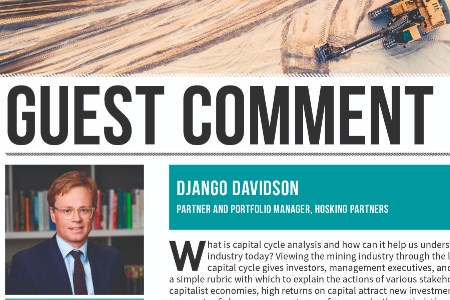Django Davidson, Partner and Portfolio Manager, Hosking Partners, highlights how the capital cycle approach gives investors a simple rubric with which to explain the actions of various stakeholders within the industry.
What is capital cycle analysis and how can it help us understand the mining industry today? Viewing the mining industry through the lens of the capital cycle gives investors, management executives, and policymakers a simple rubric with which to explain the actions of various stakeholders. In capitalist economies, high returns on capital attract new investment. The prospects of above-average returns – for example, the optimistic outlook for the wind generation sector in the early 2010s – are followed by capital inflows. This process raises valuations and attracts ever more capital. After all, if one can build a wind-turbine for 100 but have it valued by the stock market at 200, the incentives for promoters are clear. The reverse also applies. Sustained periods of low returns on capital work to repel investment, ultimately leading to reduced capacity. If the equity market consistently values an industry or company below what it would cost to ‘replace’ its assets, the rational management response is to reallocate capital out of the business.How does this apply to the mining sector? The over-build and value-destructive M&A that characterised the expansionary super-cycle has now given way to a new era, one in which management incentives are focused on returns rather than expansion. The past decade has seen mining industry capital expenditure budgets slashed from around US$165 billion in 2012 to just US$100 billion in 2021 – despite the inflationary pressures. Most of the major mining houses have embraced share buyback schemes, which, given the persistently low valuation of the sector, is rational. A major implication, as we enter this phase of the capital cycle, is that commodity supply will necessarily contract. For supply to grow, returns on industry capital need to reach a level that justifies new investment. And the industry is a long way off earning supernormal profits.Whilst all commodities are at different stages in their respective cycles, the copper industry is perhaps the most vivid illustration. To sustain current copper production, heavy investment in existing (often low and declining grade) mines is required. It is also necessary to find new sources of supply, yet only a handful of new copper mines have been discovered in the past decade, in arguably more challenging geographies. According to Bloomberg Intelligence, the average lead time from first discovery to first metal has increased by four years from previous cycles, to almost 14 years in 2021. We are spending less money on existing assets, finding fewer new resources, and, when we do find them, they are taking longer to reach production.This situation in copper is exacerbated by ESG trends which, perversely, make it harder to expand capacity. Who wants a new copper mine on their doorstep? One analysis suggests that, to hit net zero by 2050, 1.4 billion t of copper will need to be mined – more than twice the total amount extracted since the start of human history. Hosking Partners will pass no comment on whether these demand-based forecasts will come to fruition. However, with many copper companies generating returns at or below their cost of capital, the prospect of a wave of new capital unlocking a wave of new supply is remote. The cycle has a long way to run. As do investor returns.
Read the article online at:
This article was published by:
Visit the original article here



